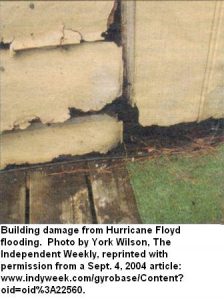Maple Hill: What happened?
In 1999, Hurricane Floyd dropped over 20 inches of rain in the eastern regions of the state. In Pender County, the floodwaters created by this rain rose above the 500-year flood stage level. Statewide, more than 48,000 people were forced out of their homes and into shelters.
People felt the immediate effects of the flood in multiple ways. Across eastern North Carolina, more than 50 deaths were attributed to the storm. Many wells, creeks, and rivers were contaminated by dead livestock, chemical spills, human sewage from wastewater treatment plants and septic tanks, and the overflow of animal waste lagoons from industrial hog farms. As a result of the flooding, hundreds of homes were deemed uninhabitable.
State and federal governments acted quickly to try to alleviate the problems caused by Hurricane Floyd. The North Carolina State legislature allocated $836.6 million of disaster relief funding. The North Carolina State Emergency Response Team (SERT) helped with clean-up and provided immediate relief after the flood along with volunteers from various organizations. The Federal Emergency Management Agency (FEMA) set up relief programs and encouraged residents to seek assistance through their temporary housing, grant, and buy-out programs.
Despite these efforts, disaster relief did not progress smoothly for all residents. Cases were reported of relief workers providing misinformation, and some residents reported that their applications to relief programs were repeatedly lost. Low-income landowners faced additional barriers to receiving recovery aid, such as a hesitance to assume government loans that they did not have the means to repay. Many residents were reluctant to take advantage of government buy-out programs designed to permanently relocate residents because they did not want to leave family homesteads.
 Even as some residents were frustrated by slow progress in rebuilding, government employees were faced with changing rules guiding disaster aid and limited funds to administer programming. As time progressed, less money was allocated to disaster relief at the state and federal level, and this left Maple Hill to compete with more affluent communities in the county for dwindling funds.
Even as some residents were frustrated by slow progress in rebuilding, government employees were faced with changing rules guiding disaster aid and limited funds to administer programming. As time progressed, less money was allocated to disaster relief at the state and federal level, and this left Maple Hill to compete with more affluent communities in the county for dwindling funds.
In the five years following Hurricane Floyd, 83 homes in Maple Hill were repaired, rebuilt, or bought out. However, more than 100 homes remained in need of flood-related repairs in 2006. Flooding has damaged building foundations and led to moisture within the structures that has resulted in mold growth in walls and air conditioning ducts. Mold and mildew resulting from water damage have been linked to a variety of respiratory diseases, also a common complaint of residents.
Although residents still suffer from flood-related problems, government programs have long since dissolved. Community and non-profit groups continue to work with residents to lobby legislators and seek funding to repair damaged housing and septic systems. For example, the local chapter of NC Fair Share traveled to Raleigh in 2004 to ask state legislators for help in addressing their concerns, and they attended county commissioner meetings for a year to urge local government to apply for needed federal grants.
“After the hurricane . . . they moved a lot of [people] out of our community. They forced most of them because they would get no grant if they didn’t move, and they put them in other locales. . . . I know 15 or 20% if not more had to move out. Residents that had been here maybe 40, 50, 60, 70 years, they had to move out. . . . That was a blow for us in the community.”
– Community Member

